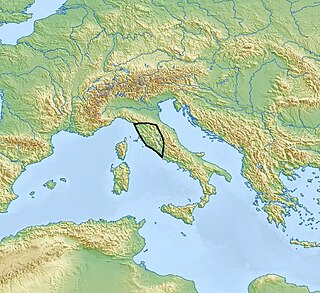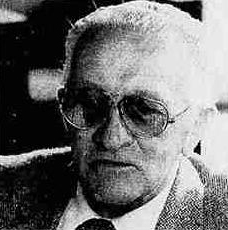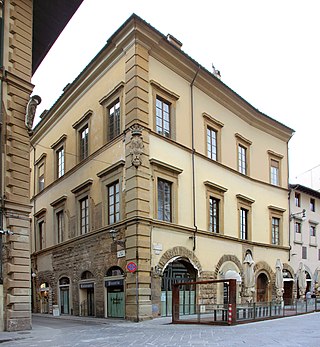The primary languages of Calabria are the Italian language as well as regional varieties of Extreme Southern Italian and Neapolitan languages, all collectively known as Calabrian. In addition, there are speakers of the Arbëresh variety of Albanian, as well as Calabrian Greek speakers and pockets of Occitan.
Canicattini Bagni is a comune (municipality) in the Province of Syracuse, Sicily (Italy), located about 190 kilometres (120 mi) southeast of Palermo and about 20 kilometres (12 mi) southwest of Syracuse. As of 31 December 2004, it had a population of 7,415 and an area of 15.1 square kilometres (5.8 sq mi).

Guglielmo della Porta was an Italian architect and sculptor of the late Renaissance or Mannerist period.

Gianfranco Miglio was an Italian jurist, political scientist, and politician. He was a founder of the Federalist Party. For thirty years, he presided over the political science faculty of Milan's Università Cattolica. Later on in his life, he was elected as an independent member of the Parliament to the Italian Senate for Lega Nord. The supporters of Umberto Bossi's party called him Prufesùr, a Lombard nickname to remember his role.

Alessandro Barbero is an Italian historian, novelist and essayist.
The Communist Party of Fiume was instituted in November 1921, after the proclamation of the Free State of Fiume created by the Treaty of Rapallo. The Communist Party of Fiume was the smallest Communist Party in the world at the time. It was founded following the principles of the Third International, according to which each sovereign State had to have its own Communist Party organization.

Pio Alessandro Carlo Fulvio Filippani Ronconi was an Italian orientalist, Waffen-SS soldier and author. He was born in Madrid, Spain, and died in Rome.

Antonio del Massaro da Viterbo, or Antonio da Viterbo, nicknamed il Pastura was an Italian painter.
William Klinger was a Croatian historian who specialized in modern Croatian and Yugoslav history as well as history of communism and nationalism.

Tivoli Cathedral is a Roman Catholic cathedral, dedicated to Saint Lawrence, in Tivoli, Lazio, Italy. It is the seat of the bishop of Tivoli.

Francesco Cattani da Diacceto, often referred to as Francesco Cattani da Diacceto il Giovane in order to distinguish him from his grandfather, the philosopher Francesco di Zanobi Cattani da Diacceto (1466–1522), was Bishop of Fiesole from 1570 until his death in 1595 and author of several works including an Essamerone ("Hexameron") and a translation into vernacular Florentine Italian of the Hexaëmeron and De Officiis Clericorum of Saint Ambrose.
The University of Lucca was an Italian university located in Lucca (LU), Italy, established in 1785 by the government of the Republic of Lucca. The university disappearing for good in 1867. There had previously been several attempts in the medieval period to found a University of Lucca: On 6 June 1369 Emperor Charles IV granted Lucca a charter for the establishment of a Studium Generale, confirmed on 13 September 1387 by Pope Urban VI. No university was actually founded, but again in 1455 Gonfalonier Giovanni Gigli tried to raise funds for a university, but once more it did not result in an actual institution.

The Rinaldone culture was an Eneolithic culture that spread between the 4th and the 3rd millennium BC in northern and central Lazio, in southern Tuscany and, to a lesser extent, also in Marche and Umbria. It takes its name from the town of Rinaldone, near Montefiascone in the province of Viterbo, northern Lazio.

Mauro Cardi is an Italian composer.

Giovanni Pietro Toesca was an Italian academic and art historian, notable as one of the most important historians of medieval to 20th century art. His La pittura e la miniatura nella Lombardia fino alla metà del Quattrocento was the first attempt to reconstruct the course of figurative Lombard art from the Middle Ages onwards, defining its importance across Europe.

Chiara Frugoni was an Italian historian and academic, specialising in the Middle Ages and church history. She was awarded the Viareggio Prize in 1994 for her essay, Francesco e l'invenzione delle stimmate.

Minerva between Geometry and Arithmetic is a fresco fragment, usually attributed to Paolo Veronese, from 1550, but by some art historians to Anselmo Canera or Giambattista Zelotti. It was painted for the Palazzo de Soranzi in Castelfranco Veneto but is now in the Palazzo Balbi, in Venice.

Massimo Mila was an Italian musicologist, music critic, intellectual and anti-fascist.

The Palazzo Naldini, or Naldini Del Riccio', or also Niccolini al Duomo, is a Florence palace located on the corner of Piazza del Duomo 28 rosso and Via dei Servi 2–4.
Eugenio Riccomini was an Italian art historian. He died on 25 December 2023, at age of 87.














